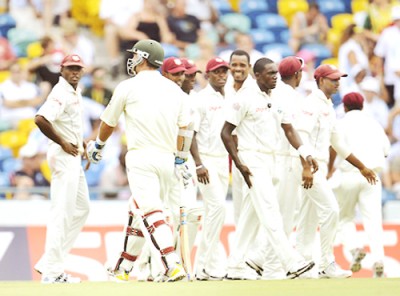It is not only the New Zealand cricket team that will confront the West Indies in the first Test, starting here tomorrow (tonight East Caribbean time).

The New Zealand weather – or, to be precise, the weather in this south island city that is Test cricket’s closest venue to the South Pole – is liable to be a significant factor in the contest between the game’s lowest ranked teams.
The temperature at noon yesterday, starting time of each day of the Test, was nine degrees Celsius under a leaden sky.
With overnight rain gradually easing and the sun breaking through the cloud, the thermometer rose to a high of 14 but it was a day distinctly more winter than summer and certainly not Caribbean.
The forecast is variable but there is likely to be more of the same through the rest of the week.
There was only one certainty for Dave Stewart, described in the Otago Daily Times yesterday as a “rain effects hydrologist” (presumably on the same basis that grave diggers are now “soil excavtors”). It was that the next few days would be wet.
“It’s a moving feast at the moment,” he said. “At one stage it looked like it would be quite wet and then another when it wasn’t looking so wet. I suspect we’ll have a cool southerly breeze with clearing weather.”
The official Meteorlogical Office was more precise. It predicted rain for tomorrow and Friday with temperatures peaking at no more than 16 degrees.
In other words, whether Stewart’s or the Met Office’s, conditions are likely to be alien to most of the West Indies players who, unlike their predecessors, have not had English county cricket to prepare them for coping with such vagaries.
It was similarly damp and biting for the West Indies Test against England at Headingley last year. On most of the four day, under low cloud, the temperature never got past 10 degrees.
Without the injured Shivnarine Chanderpaul and Ramnaresh Sarwan, the West Indies were swept aside for 146 and 141. One batsman told Sir Viv Richards that it was so cold, his eyes were fogged over.
Others seemed frozen in both the literal and figurative sense.
The heated dressing room beckoned as a warm shelter. So it might here.
Should conditions remain as predicted, it will be a stern test of character, especially for the batsmen.
Even with the unavailability of the threatening Shane Bond as the spearhead of the attack and the omission of the pacy Chris Martin and Tim Southee in the shake-up following the two heavy defeats in Australia last month that have pushed them below West Indies in the ICC rankings, New Zealand are well served by seam bowling.
Mark Gillespie, who had five wickets on debut against South Africa a year ago, returns as does the experienced left-arm swinger James Franklin, back after knee surgery. Two tall seamers, Ian O’Brien and Jacob Oram, back them up.
As is customary, the West Indies bank heavily for their runs on Sarwan, who enters the Test backed by the confidence of an unbeaten 158 against Auckland in the one match provided as warm-up, and Chanderpaul. They are the only ones here to have scored Test hundreds in the past three years.
Captain Chris Gayle and his new vice-captain Denesh Randin need to take the cue.
While Gayle has been prolific in the shorter format, his last three figures innings was 317 against South Africa in Antigua in 2005 and the University Oval here, staging its second Test in place of Carisbook, the long-time venue, is no Recreation Ground.
Wicket-keeper Ramdin fills a crucial spot at No.7, one that merits a higher average than his 21. It is 18 innings since he managed something over 50. It is time to produce.
Sewnarine Chattergoon (two Tests), Xavier Marshall (four) and Brendon Nash, expected to make his debut at No.6, are the support staff. In two Tests that will test technique and temperament, each can make early claims to long term places.
Given the weather, both teams will agonise over the composition of their bowling. Conditions will determine the final decision.
For the West Indies, the debate is over whether Sulieman Benn, the beanpole left-armer who is the only specialist spinner in the squad, should balance the attack or whether it should be all pace with the lively Lionel Baker in for his debut Test to join Jerome Taylor, Darren Powell and Fidel Edwards.
For New Zealand, the additional spin option in Jetan Patel’s flighted off-breaks to complement captain Daniel Vettori’s quality left-arm variety.
If favoured, one of the faster bowlers would make way.
It is a new start for the home team.
Andy Moles, an Englishman who had a productive playing career at Warwickshire, succeeds John Bracewell as coach. His style will be different, he says, and his team certainly is, with four changes to the one thumped 2-0 by Australia in Australia last month.
A public shocked by New Zealand’s slide to the bottom of the Test heap is demanding an immediate transformation. They might see the West Indies, only a decimal point ahead in seventh and beaten in each of the last three series between the teams, as a good place to start.
The West Indies have waited over a decade for their own, elusive turnaround. There is no better time to finally trigger it than in the two Tests here. But they need to weather to cooperate.
Teams: West Indies (expected): Chris Gayle (captain), Sewnarine Chattergoon, Ramnaresh Sarwan, Xavier Marshall, Shivnarine Chanderpaul, Brendon Nash, Denesh Ramdin, Jerome Taylor, Daren Powell, Fidel Edwards, Sulieman Benn or Lionel Baker. New Zealand (from): Daniel Vettori (captain), Jamie How, Tim McIntosh, Daniel Flynn, Ross Taylor, Jesse Ryder, Jacob Oram, Brendon McCullum (wk), James Franklin, Mark Gillespie, Iain O’Brien, Jeetan Patel.
Umpires: Rudi Koertzen and Amiesh Saheba (Mark Benson, third umpire)




